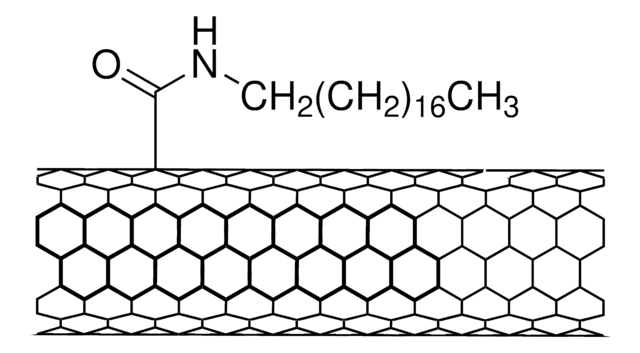755125
Carbon nanotube, multi-walled
carboxylic acid functionalized,>90% carbon basis, D × L 9.5 nm × 1.5 μm
Sinónimos:
Carbon nanotube, multi-walled, carboxylic acid functionalized
About This Item
Productos recomendados
product name
Carbon nanotube, multi-walled, carboxylic acid functionalized, thin, extent of labeling: >8% carboxylic acid functionalized, avg. diam. × L 9.5 nm × 1.5 μm
descripción
carboxylic acid functionalized
Análisis
>80% carbon basis
formulario
powder
características de los productos alternativos más sostenibles
Design for Energy Efficiency
Learn more about the Principles of Green Chemistry.
sustainability
Greener Alternative Product
Extensión del etiquetado
>8% carboxylic acid functionalized
diám. prom. × L
9.5 nm × 1.5 μm
grupo funcional
carboxylic acid
categoría alternativa más sostenible
, Enabling
Categorías relacionadas
Descripción general
Aplicación
Deposition (CCVD) process. Applications include Electronics; 1 Sensors; 2 Composites; Energy Storage and Study of Life Science systems.3
Nota de preparación
Información legal
Código de clase de almacenamiento
13 - Non Combustible Solids
Clase de riesgo para el agua (WGK)
WGK 3
Punto de inflamabilidad (°F)
Not applicable
Punto de inflamabilidad (°C)
Not applicable
Certificados de análisis (COA)
Busque Certificados de análisis (COA) introduciendo el número de lote del producto. Los números de lote se encuentran en la etiqueta del producto después de las palabras «Lot» o «Batch»
¿Ya tiene este producto?
Encuentre la documentación para los productos que ha comprado recientemente en la Biblioteca de documentos.
Los clientes también vieron
Artículos
Find unique properties & applications of single (SWNTs) , double (DWNTs) & multi walled carbon nanotubes (MWCNTs).
Boron nitride nanotubes (BNNT) are close structural analogs of carbon nanotubes (CNT), which are high aspect ratio nanotubular material, where carbon atoms are alternately substituted by nitrogen and boron atoms.
Professor Rivnay (Northwestern University, USA) discusses using organic mixed conductors as an alternative to efficiently bridge the ionic world of biology with contemporary microelectronics.
Carbon nanotubes (CNTs) have received much attention since their discovery in 1991 by Sumio lijima1 due to their excellent mechanical, electrical, and optical properties.
Nuestro equipo de científicos tiene experiencia en todas las áreas de investigación: Ciencias de la vida, Ciencia de los materiales, Síntesis química, Cromatografía, Analítica y muchas otras.
Póngase en contacto con el Servicio técnico





